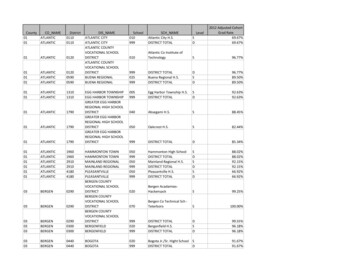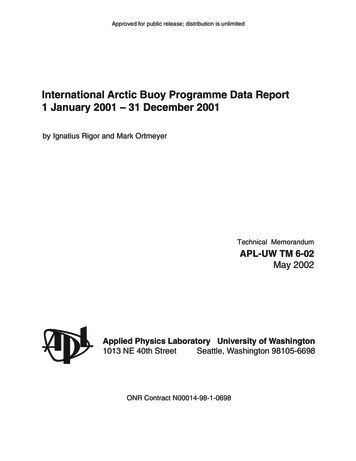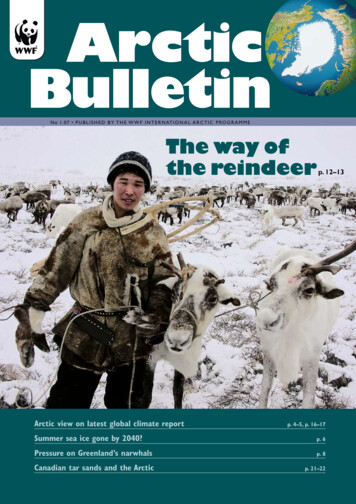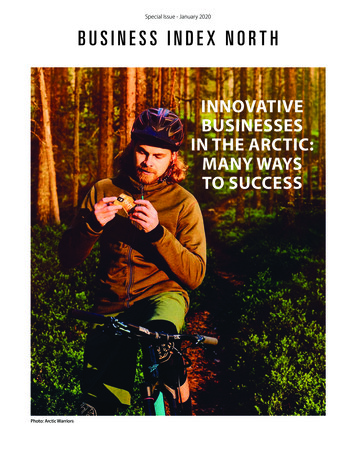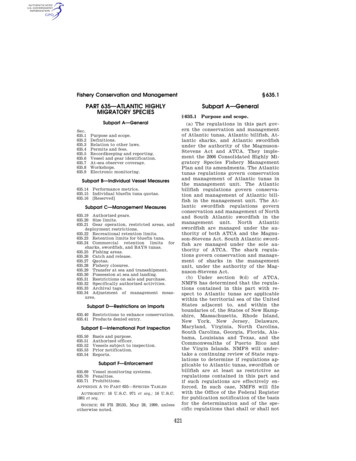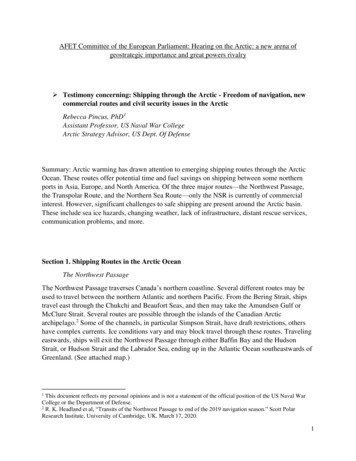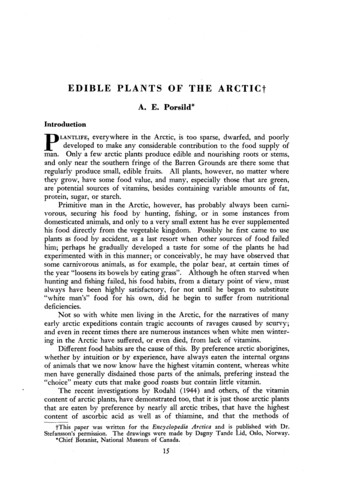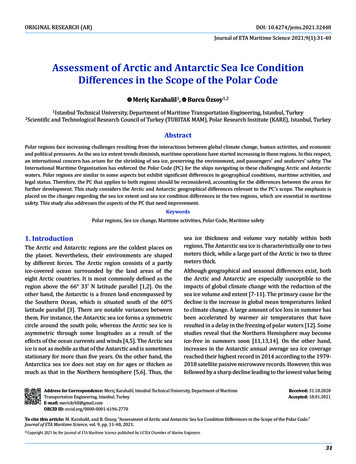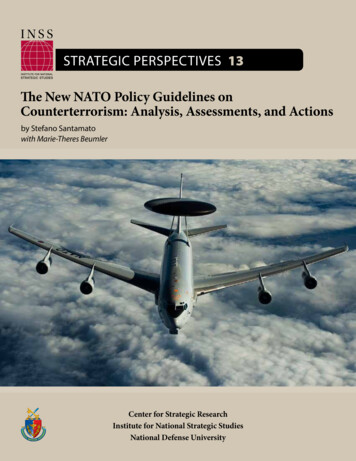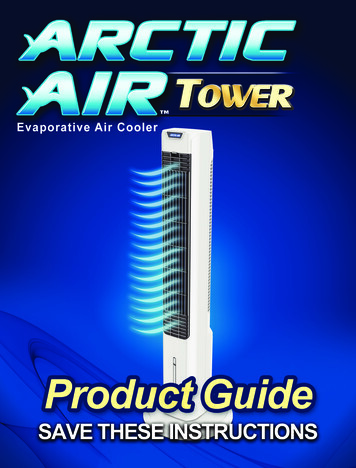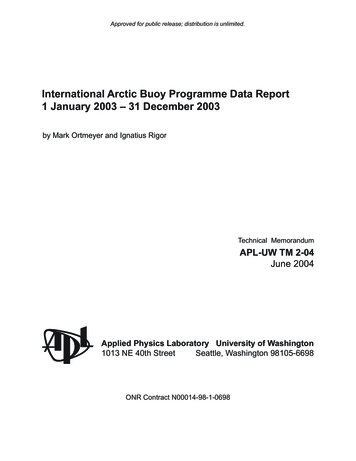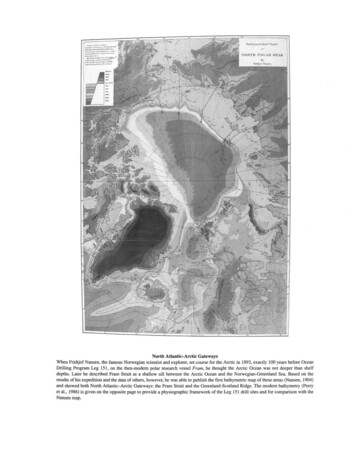
Transcription
North Atlantic-Arctic GatewaysWhen Fridtjof Nansen, the famous Norwegian scientist and explorer, set course for the Arctic in 1893, exactly 100 years before OceanDrilling Program Leg 151, on the then-modern polar research vessel Fram, he thought the Arctic Ocean was not deeper than shelfdepths. Later he described Fram Strait as a shallow sill between the Arctic Ocean and the Norwegian-Greenland Sea. Based on theresults of his expedition and the data of others, however, he was able to publish the first bathymetric map of these areas (Nansen, 1904)and showed both North Atlantic-Arctic Gateways: the Fram Strait and the Greenland-Scotland Ridge. The modern bathymetry (Perryet al., 1986) is given on the opposite page to provide a physiographic framework of the Leg 151 drill sites and for comparison with theNansen map.
PROCEEDINGSOF THEOCEAN DRILLINGPROGRAMVOLUME 151INITIAL REPORTSNORTH ATLANTIC-ARCTIC GATEWAYS ICovering Leg 151 of the cruises of the Drilling Vessel JOIDES Resolution,St. John's Harbor, Newfoundland, to Reykjavik, Iceland, Sites 907-913,24 July-24 September 1993Annik M. Myhre, Jörn Thiede, John V. Firth,Naokazu Ahagon, Kevin S. Black, Jan Bloemendal, Garrett W. Brass,James F. Bristow, Nancy Chow, Michel Cremer, Linda Davis, Benjamin Flower, Torben Fronval,Julie Hood, Donna Hull, Nalan Koç, Birger Larsen, Mitchell W. Lyle, Jerry McManus,Suzanne O'Connell, Lisa Ellen Osterman, Frank R. Rack, Tokiyuki Sato, Reed P. Scherer,Dorothee Spiegler, Ruediger Stein, Mark Tadross, Stephen Wells, David Williamson,Bill Witte, Thomas Wolf-WellingShipboard ScientistsJohn V. FirthShipboard Staff ScientistPrepared by theOCEAN DRILLING PROGRAMTEXAS A&M UNIVERSITYJennifer A. MarinVolume Editorin cooperation with theNATIONAL SCIENCE FOUNDATIONandJOINT OCEANOGRAPHIC INSTITUTIONS, INC.
This publication was prepared by the Ocean Drilling Program, Texas A&M University, as an account ofwork performed under the international Ocean Drilling Program, which is managed by Joint Oceanographic Institutions, Inc., under contract with the National Science Foundation. Funding for the programwas provided by the following agencies at the time of this cruise:Canada/Australia Consortium for the Ocean Drilling Program, Department of Energy, Mines andResources (Canada), and Department of Primary Industries and Energy (Australia)Deutsche Forschungsgemeinschaft (Federal Republic of Germany)European Science Foundation Consortium for Ocean Drilling (Belgium, Denmark, Finland, Iceland, Italy,Greece, The Netherlands, Norway, Spain, Sweden, Switzerland, and Turkey)Institut Français de Recherche pour 1 Exploitation de la Mer (France)National Science Foundation (United States)Natural Environment Research Council (United Kingdom)University of Tokyo, Ocean Research Institute (Japan)Any opinions, findings, and conclusions or recommendations expressed in this publication are those of theauthor(s) and do not necessarily reflect the views of the National Science Foundation, the participatingagencies, Joint Oceanographic Institutions, Inc., Texas A&M University, or Texas A&M Research Foundation.It is recommended that reference to the whole or to part of this volume be made in one of the followingforms, as appropriate:Print citation:Myhre, A.M., Thiede, J., Firth, J.V., et al., 1995. Proc. ODP, Init. Repts., 151: College Station, TX (OceanDrilling Program).Shipboard Scientific Party, 1995. Site 907. In Myhre, A.M., Thiede, J., Firth, J.V., et al., Proc. ODP, Init.Repts., 151: College Station, TX (Ocean Drilling Program), 57-111.Electronic citation:Myhre, A.M., Thiede, J., Firth, J.V., et al., 1995. Proc. ODP, Init. Repts. [CD-ROM], 151. Available: OceanDrilling Program, Texas A&M University, College Station, TX.Shipboard Scientific Party, 1995. Site 907. In Myhre, A.M., Thiede, J., Firth, J.V., et al., Proc. ODP, Init.Repts. [CD-ROM], 151, 57-111. Available: Ocean Drilling Program, Texas A&M University, CollegeStation, TX.Effective Publication Dates of ODP ProceedingsAccording to the International Code of Zoological Nomenclature, the date of publication of a work and of acontained name or statement affecting nomenclature is the date on which the publication was mailed tosubscribers, placed on sale, or when the whole edition is distributed free of charge, mailed to institutionsand individuals to whom free copies are distributed. The mailing date, not the printed date, is correct.The mailing dates of recent Proceedings of the Ocean Drilling Program are as follows:Volume 149 {Initial Reports): June 1994Volumes 15O/15OX {Initial Reports): November 1994Volume 152 {Initial Reports): December 1994Volume 134 {Scientific Results): October 1994Volume 135 {Scientific Results): May 1994Volume 139 {Scientific Results): October 1994DistributionCopies of this publication may be obtained from Publications Distribution Center, Ocean Drilling Program,1000 Discovery Drive, College Station, Texas 77845-9547, U.S.A. Orders for copies will require advancepayment. See current ODP publication list for price and availability of this publication.Printed March 1995ISSN 0884-5883Library of Congress 87-655-674Printed in Canada by D.W. Friesen & Sons Ltd.The paper used in this publication meets the minimum requirements of American National Standard for Information SciencesPermanence of Paper for Printed Library Materials, ANSI Z39.48-1984
ForewordBy the National Science FoundationThe National Science Foundation is proud to play a leading role in partnership with theU.S. Oceanographic community in the operation and management of the Ocean DrillingProgram (ODP). We are equally proud of the cooperation and commitment of our international partners, who contribute both financial and intellectual resources required to maintain the high quality of this unique program. The Ocean Drilling Program, like itspredecessor, the Deep Sea Drilling Project (DSDP), is a model for the organization andplanning of research to address global scientific problems that are of high priority internationally and of long-term interest to the scientific community and general public.Major scientific themes guiding the development of specific drilling cruises range fromdetermining the causes and effects of oceanic and climatic variability to understanding thecirculation of fluids in the ocean crust and the resultant formation of mineral deposits.Although such studies are at the forefront of basic scientific inquiry into the processes thatcontrol and modify the global environment, they are equally important in providing thebackground for assessing man's impact on the global environment or for projectingresource availability for future generations.The transition from the DSDP to the ODP was marked by a number of changes. The471-foot JOIDES Resolution, which replaced the Glomar Challenger, has allowed largerscientific parties and the participation of more graduate students, a larger laboratory andtechnical capability, and operations in more hostile ocean regions. The JOIDES Resolutionhas drilled in all of the world's oceans, from the marginal ice regions of the Arctic towithin sight of the Antarctic continent. Over 1,200 scientists and students from 26 nationshave participated on project cruises. Cores recovered from the cruises and stored in ODPrepositories in the United States and Europe have provided samples to an additional 1,000scientists for longer term post-cruise research investigations. The downhole geochemicaland geophysical logging program, unsurpassed in either academia or industry, is providingremarkable new data with which to study the Earth.In 1994, NSF and our international partners renewed our commitment to the programfor its final phase. Of the 20 countries that supported ODP initially, only one, Russia, hasbeen unable to continue for financial reasons. As the reputation and scientific impact ofthe program continue to grow internationally, we hope to add additional members and newscientific constituencies. This global scientific participation continues to assure the program scientific excellence by focusing and integrating the combined scientific knowledge and capabilities of its member nations.We wish the program smooth sailing and good drilling!Neal LaneDirectorNational Science FoundationArlington, Virginia
ForewordBy Joint Oceanographic Institutions, Inc.This volume presents scientific and engineering results from the Ocean Drilling Program (ODP). The papers presented here address the scientific and technical goals of theprogram, which include providing a global description of geological and geophysicalstructures including passive and active margins and sediment history, and studying indetail areas of major geophysical activity such as mid-ocean ridges and the associatedhydrothermal circulations.The Ocean Drilling Program, an international activity, operates a specially equippeddeep-sea drilling ship, the JOIDES Resolution (Sedco/BP 471), which contains state-ofthe-art laboratories, equipment, and computers. The ship is 471 feet (144 meters) long, is70 feet (21 meters) wide, and has a displacement of 18,600 short tons. Her derrick towers211 feet (64 meters) above the waterline, and a computer-controlled dynamic-positioningsystem stabilizes the ship over a specific location while drilling in water depths up to27,000 feet (8230 meters). The drilling system collects cores from beneath the seafloorwith a derrick and drawworks that can handle 30,000 feet (9144 meters) of drill pipe.More than 12,000 square feet (1115 square meters) of space distributed throughout theship is devoted to scientific laboratories and equipment. The ship sails with a scientificand technical crew of 51 and a ship's crew (including the drill crew) of 62. The size andice-strengthening of the ship allow drilling in high seas and ice-infested areas as well aspermit a large group of multidisciplinary scientists to interact as part of the scientific party.Logging, or measurements in the drilled holes, is an important part of the program.ODP provides a full suite of geochemical and geophysical measurements for every holedeeper than 1300 feet (400 meters). For each such hole, there are lowerings of basicoil-industry tools: nuclear, sonic, and electrical. In addition, a borehole televiewer is available for imaging the wall of the hole, a 12-channel logging tool provides accurate velocityand elastic property measurements as well as sonic waveforms for spectral analysis ofenergy propagation near the wall of the hole, and a vertical seismic profiler can recordreflectors from below the total depth of the hole.The management of the Ocean Drilling Program involves a partnership of scientistsand governments. International oversight and coordination are provided by the ODPCouncil, a governmental consultative body of the partner countries, which is chaired by arepresentative from the United States National Science Foundation. The ODP Councilperiodically reviews the general progress of the program and discusses financial plans andother management issues. Overall scientific and management guidance is provided to theoperators of the program by representatives from the group of institutions involved in theprogram, called the Joint Oceanographic Institutions for Deep Earth Sampling (JOIDES).The Executive Committee (EXCOM), made up of the administrative heads of theJOIDES institutions, provides general oversight for ODP. The Planning Committee(PCOM), with its advisory structure, is made up of working scientists and provides scientific advice and detailed planning. PCOM has a network of panels and working groups thatscreen drilling proposals, evaluate instrumentation and measurement techniques, andassess geophysical-survey data and other safety and siting information. PCOM uses therecommendations of the panels and committees to select drilling targets, to specify thelocation and major scientific objectives of each two-month drilling segment or leg, and toprovide the science operator with nominations for co-chief scientists.Joint Oceanographic Institutions, Inc. (JOI), a nonprofit consortium of U.S. Oceanographic institutions, serves as the National Science Foundation prime contractor forODP. JOI is responsible for seeing that the scientific objectives, plans, and recommendations of the JOIDES committees are translated into scientific operations consistent withscientific advice and budgetary constraints. JOI subcontracts the operations of the program to two universities: Texas A&M University and Lamont-Doherty Earth Observatoryof Columbia University. JOI is also responsible for managing the U.S. contribution toODP.
Texas A&M University (TAMU) serves as science operator for ODP. In this capacity,TAMU is responsible for planning the specific ship operations, actual drilling schedules,and final scientific rosters, which are developed in close cooperation with PCOM and therelevant panels. The science operator also ensures that adequate scientific analyses areperformed on the cores by maintaining the shipboard scientific laboratories and computersand by providing logistical and technical support for shipboard scientific teams. Onshore,TAMU manages scientific activities after each leg, is curator for the cores, distributessamples, and coordinates the editing and publication of scientific results.Lamont-Doherty Earth Observatory (LDEO) of Columbia University is responsible forthe program's logging operation, including processing the data and providing assistance toscientists for data analysis. The ODP Data Bank, a repository for geophysical data, is alsomanaged by LDEO.Core samples from ODP and the previous Deep Sea Drilling Project are stored forfuture investigation at four sites: ODP Pacific and Indian Ocean cores at TAMU, DSDPPacific and Indian Ocean cores at the Scripps Institution of Oceanography, ODP andDSDP Atlantic and Antarctic cores through Leg 150 at LDEO, and ODP Atlantic and Antarctic cores since Leg 151 at the University of Bremen, Federal Republic of Germany.Scientific achievements of ODP include new information on early seafloor spreadingand how continents separate and the margins evolve. The oldest Pacific crust has beendrilled and sampled. We have new insights into glacial cycles and the fluctuations ofocean currents throughout geological time. Many of the scientific goals can be met onlywith new technology; thus the program has focused on engineering as well as science. Todate, ODP engineers have demonstrated the capability to drill on bare rock atmid-ocean-ridge sites and have developed techniques for drilling in high-temperature andcorrosive regions typical of hydrothermal vent areas. A new diamond coring system promises better core recovery in difficult areas.In addition, ODP is cooperating closely with other geological and geophysical programs; for example, in 1991 the first hole was drilled by ODP for emplacement of a seismometer near Hawaii for the Ocean Seismic Network. JOI is pleased to have been able toplay a facilitating role in the Ocean Drilling Program and its cooperative activities, and weare looking forward to many new results to come.D. James BakerPresidentJoint Oceanographic Institutions, Inc.Washington, D.C.
OCEAN DRILLING PROGRAMMEMBER ORGANIZATIONS OF THE JOINTOCEANOGRAPHIC INSTITUTIONS FORDEEP EARTH SAMPLING (JOIDES):University of California at San Diego, Scripps Institutionof OceanographyColumbia University, Lamont-Doherty Earth ObservatoryUniversity of Hawaii, School of Ocean and Earth Scienceand TechnologyUniversity of Miami, Rosenstiel School of Marine andAtmospheric ScienceOregon State University, College of Oceanic andAtmospheric SciencesUniversity of Rhode Island, Graduate School ofOceanographyTexas A&M University, College of Geosciences andMaritime StudiesUniversity of Texas at Austin, Institute for GeophysicsUniversity of Washington, College of Ocean and FisherySciencesWoods Hole Oceanographic InstitutionCanada/Australia Consortium for the Ocean DrillingProgram, Department of Energy, Mines and Resources(Canada) and Department of Primary Industries andEnergy (Australia)European Science Foundation Consortium for OceanDrilling (Belgium, Denmark, Finland, Iceland, Italy,Greece, The Netherlands, Norway, Spain, Sweden,Switzerland, and Turkey)Federal Republic of Germany, Bundesanstalt fürGeowissenschaften und RohstoffeFrance, Institut Français de Recherche pour 1'Exploitationde la MerJapan, University of Tokyo, Ocean Research InstituteUnited Kingdom, Natural Environment Research CouncilPRIME CONTRACTORJoint Oceanographic Institutions, Inc.Washington, D.C.Thomas E. PyleDirector, Ocean Drilling ProgramsOPERATING INSTITUTIONCollege of Geosciences and Maritime StudiesTexas A&M UniversityCollege Station, TexasRobert A. DuceDeanOCEAN DRILLING PROGRAMPhilip D. RabinowitzDirectorTimothy J.G. FrancisDeputy DirectorRichard G. McPhersonAdministratorJack G. Baldauf, ManagerScience OperationsBarry W. Harding, ManagerEngineering and Drilling OperationsRussell B. Merrill, Curator and ManagerScience ServicesRobert E. Olivas, ManagerTechnical and Logistics SupportJohn Coyne, ManagerInformation ServicesLOGGING OPERATORBorehole Research GroupLamont-Doherty Earth ObservatoryColumbia UniversityPalisades, New YorkDavid Goldberg, Head
PARTICIPANTS ABOARD THE JOIDES RESOLUTIONAnnik M. MyhreCo-Chief ScientistDepartment of GeologyUniversity of OsloPB 1047, BlindernN-0316 Oslo 3NorwayFOR LEG 151Nancy ChowSedimentologistDepartment of Geological SciencesUniversity of ManitobaWinnipeg, Manitoba R3T 2N2CanadaJörn ThiedeCo-Chief ScientistGEOMARResearch Centre for Marine GeosciencesWischhofstrasse 1-3, Gebàude 4D-24148 Kiel 14Federal Republic of GermanyMichel CremerSedimentologistDépartement de Géologie et OceanographicURA CNRS 197Université de Bordeaux 1Avenue des Facultés33405 Talence CedexFranceJohn V. FirthODP Staff ScientistOcean Drilling ProgramTexas A&M University Research Park1000 Discovery DriveCollege Station, Texas 77845-9547U.S.A.Linda DavisIgneous PetrologistDepartment of Geological SciencesUniversity of Texas at AustinP.O. Box 7909Austin, Texas 78712-7909U.S.A.Naokazu AhagonSedimentologistMarine Geology and GeophysicsOcean Research InstituteUniversity of Tokyo1-15-1 Minamidai, Nakano-kuTokyo 164JapanBenjamin FlowerSedimentologistDepartment of Geological SciencesUniversity of California, Santa BarbaraSanta Barbara, California 93106U.S.A.Kevin S. BlackPhysical Properties SpecialistSchool of Ocean SciencesUniversity of Wales (Bangor)Menai BridgeAnglesey Gwynedd LL59 5HNUnited KingdomJan BloemendalStratigraphic CoordinatorDepartment of GeologyUniversity of LiverpoolP.O. Box 147Liverpool L69 3BXUnited KingdomGarrett W. BrassInorganic GeochemistDivision of Marine Geology and GeophysicsRosenstiel School of Marine and Atmospheric ScienceUniversity of Miami4600 Rickenbacker CausewayMiami, Florida 33149-1098U.S.A.James F. BristowLDEO Logging ScientistBorehole ResearchDepartment of GeologyUniversity of LeicesterLeicester LEI 7RHUnited Kingdom* Addresses at time of cruise.Torben FronvalSedimentologistGeologisk InstituttUniversitetet i BergenAllégaten 41N-5007 BergenNorwayJulie HoodPhysical Properties SpecialistDivision of Marine Geology and GeophysicsRosenstiel School of Marine and Atmospheric ScienceUniversity of Miami4600 Rickenbacker CausewayMiami, Florida 33149-1098U.S.A.Donna HullPaleontologist (radiolarians)Programs in GeosciencesUniversity of Texas, DallasP.O. Box 830688Richardson, Texas 75083-0688U.S.A.Nalan KoçPaleontologist (diatoms)Geologisk InstituttUniversitetet i BergenAllégaten 41N-5007 BergenNorway
Birger LarsenPhysical Properties SpecialistDanmarks Geologiske UndersΦgelseThoravej 8DK-2400 Copenhagen NVDenmarkRuediger SteinOrganic GeochemistAlfred Wegener Institute for Polar and Marine ResearchColumbusstrasse 2D-27568 BremerhavenFederal Republic of GermanyMitchell W. LyleJOIDES Logging ScientistCGISSDepartment of GeosciencesBoise State UniversityBoise, Idaho 83725U.S.A.David WilliamsonPaleomagnetistLaboratoire de Géologie du QuaternaireCNRS, Case 907Faculté des Sciences de Luminy13288 Marseille Cedex 9FranceJerry McManusSedimentologistDivision of Oceans and ClimateLamont-Doherty Earth ObservatoryColumbia UniversityPalisades, New York 10964U.S.A.Bill WittePaleomagnetistGeophysical InstituteUniversity of AlaskaFairbanks, Alaska 99775U.S.A.Suzanne O'ConnellSedimentologistDepartment of Earth and Environmental SciencesWesleyan UniversityMiddletown, Connecticut 06459-6034U.S.A.Lisa Ellen OstermanPaleontologist (benthic foraminifers)Department of PaleobiologyNHB E207Smithsonian InstitutionWashington, DC 20560U.S.A.Frank R. RackPhysical Properties SpecialistOcean Mapping GroupDepartment of Surveying EngineeringUniversity of New BrunswickP.O. Box 4400Fredericton, New Brunswick E3B 5A3CanadaTokiyuki SatoPaleontologist (nannofossils)Institute of Applied Earth SciencesMining CollegeAkita UniversityTegata-Gakuencho 1-1Akita 010JapanReed P. SchererPaleontologist (diatoms)Byrd Polar Research CenterOhio State University1090 Carmack RoadColumbus, Ohio 43210-1002U.S.A.Dorothee SpieglerPaleontologist (planktonic foraminifers, Bolboforma)GEOMARResearch Centre for Marine GeosciencesWischhofstrasse 1-3, Gebaude 4D-24148 Kiel 14Federal Republic of GermanyThomas Wolf-WellingSedimentologistGEOMARResearch Centre for Marine GeosciencesWischhofstrasse 1-3, Gebaude 4D-24148 Kiel 14Federal Republic of GermanyPARTICIPANTS ABOARD ICE-SUPPORTVESSEL FENNICAMark TadrossSea-Ice PhysicistScott Polar Research InstituteUniversity of CambridgeLensfield RoadCambridge CB2 1ERUnited KingdomStephen WellsSea-Ice PhysicistScott Polar Research InstituteUniversity of CambridgeLensfield RoadCambridge CB2 1ERUnited KingdomSEDCO OFFICIALSCaptain Edwin G. OonkMaster of the Drilling VesselOverseas Drilling Ltd.SEDCO Forex707 Texas Avenue South, Suite 103DCollege Station, Texas 77840-1917U.S.A.Kenneth D. HorneDrilling SuperintendentOverseas Drilling Ltd.SEDCO Forex707 Texas Avenue South, Suite 103DCollege Station, Texas 77840-1917U.S.A.
ODP ENGINEERING AND OPERATIONS PERSONNELGene PollardOperations SuperintendentODP TECHNICAL AND LOGISTICS PERSONNELWendy J. AutioTimothy BronkBrenda Jo ClaesgensBradley CookCesar FloresDennis K. GrahamMargaret HastedtKazushi ("Kuro") KurokiJaquelyn K. LedbetterJon S. LloydErinn McCartyMatt MefferdWilliam G. MillsDwight E. MossmanAnne PimmelWilliam StevensMark WatsonMarine Laboratory Specialist/X-ray, PaleontologyMarine Laboratory Specialist/Storekeeper, Thin SectionMarine Laboratory Specialist/YeopersonMarine Laboratory Specialist/PhotographyMarine Computer Specialist/System ManagerMarine Laboratory Specialist/ChemistryMarine Laboratory Specialist/MagneticsAssistant Laboratory Officer, X-ray, UnderwayMarine Laboratory Specialist/Downhole MeasurementsMarine Laboratory Specialist/Physical PropertiesMarine Laboratory Specialist/Curatorial RepresentativeMarine Computer Specialist/System ManagerLaboratory OfficerMarine Laboratory Specialist/Underway, FantailMarine Laboratory Specialist/ChemistryMarine Electronics SpecialistMarine Electronics SpecialistOcean Drilling Program Publications StaffPublications SupervisorWilliam D. RoseSenior Publications CoordinatorJanalisa Braziel SoltisChief IllustratorDeborah L. PartainChief EditorAnn KlausPublications CoordinatorGudelia ("Gigi") DelgadoEditorsChryseis O. FoxEva M. MaddoxJennifer A. MarinNancy K. McQuistionSondra K. StewartPublications Distribution SpecialistAlexandra F. MorenoIllustratorsMelany R. Borsack (lead, this volume)L. Michelle BriggsMichelle CadyGarnet D. Gaither*Linda C. Orsi*Monica E. RuiChief Production EditorJennifer Pattison HallProduction EditorsMauri L. Coulter*Jaime A. Gracia (this volume)William J. MoranData Entry/Copier OperatorAnn MitchellSenior PhotographerJohn W. BeckPhotographerBradley James CookProduction AssistantsCarrie R. CastillónAngeline T. MillerMary Elizabeth MitchellStudent AssistantsPamela Ivette Baires, Shanna Olesko Collie,* Michael F. Cordova, Shelley Rene Cormier, Stephanie Dusek,* Susan Goodpasture, Amy Knapp,*Lisa Nicole Larson,* Ivy E. Oliver, M. Kathleen Phillips, Tai-Fang Wu, Yvonne C. Zissa:No longer with ODP Publications.
TABLE OF CONTENTSVOLUME 151—INITIAL REPORTSAcknowledgments1SECTION 1: INTRODUCTION1. North Atlantic-Arctic GatewaysA.M. Myhre and J. Thiede2. Explanatory NotesShipboard Scientific Party527Introduction27Core descriptions28Sediment gneous petrology36Inorganic geochemistry36Organic geochemistry36Physical properties37Downhole measurements39Onshore log processing433. Underway GeophysicsA.M. Myhre, J. Thiede, and J.V. Firth474. Sea Ice PhysicsS. Wells, M. Tadross, and Shipboard Scientific Party49SECTION 2: SITE CHAPTERS5. Site 907Shipboard Scientific Party57Site summary57Principal results57Background and scientific tigraphy69Paleomagnetics74Igneous petrology77Inorganic geochemistry80Organic geochemistry84Physical properties86Downhole measurements92Seismic stratigraphy95
6. Site 908Shipboard Scientific Party113Site summary113Principal results113Background and tratigraphy122Paleomagnetics125Inorganic geochemistry129Organic geochemistry131Physical properties136Downhole measurements139Seismic stratigraphy1497. Site 909Shipboard Scientific Party159Site summary159Principal results159Background and tratigraphy171Paleomagnetics176Inorganic geochemistry181Organic geochemistry184Physical properties194Downhole measurements200Seismic stratigraphy2058. Site 910Shipboard Scientific Party221Site summary221Principal results221Background and tratigraphy230Paleomagnetics236Inorganic geochemistry239Organic geochemistry241Physical properties243Downhole measurements255Seismic stratigraphy2619. Site 911Shipboard Scientific Party271Site summary271Principal results271Background and objectives272
7Paleomagnetics281Inorganic geochemistry285Organic geochemistry288Physical properties291Downhole measurements297Seismic stratigraphy30410. Site 912Shipboard Scientific Party319Site summary319Principal results319Background and tratigraphy326Paleomagnetics329Inorganic geochemistry332Organic geochemistry333Physical properties33611. Site 913Shipboard Scientific Party345Site summary345Principal results345Background and tratigraphy360Paleomagnetics365Inorganic geochemistry366Organic geochemistry368Physical properties372SECTION 3: SUMMARY AND CONCLUSIONS12. Hydrocarbon measurements at Arctic Gateways sites (ODP Leg 151)R. Stein, G. Brass, D. Graham, A. Pimmel, and the Shipboard Scientific Party13. Cenozoic Northern Hemisphere polar and subpolar ocean paleoenvironments (Summaryof ODP Leg 151 drilling results)J. Thiede, A.M. Myhre, J.V. Firth, and the Shipboard Scientific Party385397SECTION 4: SEA ICE LOG14. Sea Ice Observations LogS. Wells, M. Tadross, D. Garbett, and Shipboard Scientific Party423
SECTION 5: REFERENCESReferences455SECTION 6: CORESCore description forms and core photographs for:Site 907465Site 908497Site 909543Site 910655Site 911701Site 912783Site 913803SECTION 7: SMEAR SLIDESSmear slide descriptions for:Site 907849Site 908853Site 909859Site 910867Site 911871Site 912877Site 913879SECTION 8: THIN SECTIONSThin section descriptions for Site 907885SECTION 9: SEDIMENT THIN SECTIONSSediment thin section descriptions for:Site 908895Site 909897Site 911899SECTION 10: DROPSTONE DESCRIPTIONSDropstone descriptions for:Site 907903Site 908905Site 909907Site 910909Site 911911Site 912913Site 913915SECTION 11: POLICYJOIDES Advisory Groups919Sample-Distribution Policy925
BACK-POCKET MATERIALSOversized FigureChapter 3: Figure 1. Sites 907-913 and YERM ID. A. 3.5-kHz records. B. Single-channel seismic EDO 1 profiles.C. Single-channel seismic EDO 2 profiles. D. Ship track lines.CD-ROMsThis volume contains two CD-ROMs. The first, "InitialReports, Vol. 151," includes an electronic version of thevolume in Adobe Acrobat, as well as data files. TheAcrobat Reader is included for installation on the following: a (386-based or higher) personal computer running Windows 3.1 or a Macintosh computer (68020 orlater processor). Also on this CD is a data directory withASCII copies of data tables too large to print in the volume.You are strongly urged to refer to the READ.ME file formore information.Initial Reports, Vol. 151, Directory Structure:AcrobatMacWinChapters (Acrobat viewing files linked for viewing)FiguresIndexData (ASCII data files of tables within the volume)Index (index properties)Shear (shear strength)Thermal (thermal conductivity)VelocityVCD (Acrobat viewing files of visual core descriptionforms by site, with core photographs)A second CD-ROM, entitled "Log and Core Data," contains dept-shifted and processed logging data, as well asshipboard gamma-ray attenuation porosity evaluator(GRAPE), index property, magnetic susceptibility, andnatural gamma data of cores collected on board JOIDESResolution during Leg 151. This CD was produced bythe Borehole Research Group at Lamont-Doherty EarthObservatory, the wireline logging operator for ODP.Log and Core Data Directory Structure:GENERAL INFORMATION directoryFormat documentation fileINDEX fileSoftware documentation fileLOGGING DATA directoryREADME documentHOLE NUMBER subdirectoryConventional logging subdirectoryGeneral information subdirectoryAcronyms and units fileProcessing history of logging data file(info.doc and/or infoswf.doc,geochem.doc)Logging data subdirectoryIndividual tool data filesGeochemical logs subdirectoryGeochemical data in ASCII format filesFMS and dipmeter data subdirectoryDipmeter file(s) in ASCII formatFMS images in portable bit map (PBM-8bit binary) format subdirectory1:1 ratio image ras
When Fridtjof Nansen, the famous Norwegian scientist and explorer, set course for the Arctic in 1893, exactly 100 years before Ocean Drilling Program Leg 151, on the then-modern polar research vessel Fram, he thought the Arctic Ocean was not deeper than shelf . This volume presents scientific and engineering results from the Ocean Drilling .
